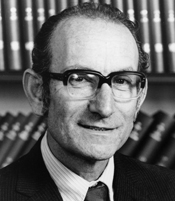César Milstein, Ph.D.

Brief Bio
César Milstein was born in Bahia Blanca, Argentina, on October 8, 1927. His father, a Jewish immigrant who made the journey from Ukraine to Argentina by himself as a teenager, and his mother, a teacher who was raised in a working class, immigrant family, made education a priority for César and his two brothers and encouraged them to attend university. Milstein earned his B.S. in biochemistry at the National University of Buenos Aries in 1952. More concerned with political activism and speaking out against the Juan Perón government than with his studies, Milstein's grades were far from distinguished. Nevertheless, he was accepted into the graduate program in chemistry at the University of Buenos Aires and began to excel as a student, completing his Ph.D. in biochemistry with a dissertation on alcohol enzymes in 1957 and earning a British Council research scholarship to the biochemistry department at the University of Cambridge. There, under the direction of the distinguished biochemist Frederick Sanger, Milstein completed a second dissertation, a study of the enzyme phosphoglucomutase, earning his Ph.D. in 1960 and joining the scientific staff of the Medical Research Council (MRC). In 1961, he accepted an appointment as head of the Department of Molecular Biology at the National Institute of Microbiology in Buenos Aires. Frustrated with the political interference in his laboratory that followed the 1962 military coup in Argentina, he returned to Cambridge in 1963 to work with Sanger at the newly formed MRC Laboratory of Molecular Biology and shifted his focus from enzymes to antibodies. By the early 1970s, he was an internationally recognized leader in the field and was able to attract talented, young researchers, including Georges Köhler, to the MRC. In 1983, he was named head of the Protein and Nucleic Acid Chemistry Division of the MRC, a position he held until his retirement in 1995.
Proud of his Jewish heritage and always up for adventure and activism, Milstein fondly recalled his "most unusual and romantic honeymoon" with his wife, Celia, whom he met at a political meeting in Buenos Aires. After they completed their undergraduate studies, the two spent 1953 hitchhiking around Europe and working for several months on kibbutzim in Israel.
Following his mother's death of a heart attack at the age of 70, Milstein learned that he had inherited her cardiovascular condition and dramatically changed his lifestyle in middle age, sticking to a regimen of strict diets and long, daily walks for the last twenty-five years of his life. On March 24, 2002, he died in Cambridge, England, at the age of 74.
Nobel Prize in Physiology or Medicine
1984 Nobel Prize in Physiology or Medicine with
Georges J. F. Köhler (AAI ’85) and
Niels Jerne (AAI '73) “for theories concerning the specificity in development and control of the immune system and the discovery of the principle for production of monoclonal antibodies.”
Lasker Award
1984 Albert Lasker Basic Medical Research Award “for his superb achievement in creating the first hybridomas, a powerful new scientific too.”
Click here for more details.
AAI Service History
Joined: 1979
Nobel Prize in Science
César Milstein was awarded the 1984 Nobel Prize in Physiology or Medicine jointly with his former postdoctoral fellow Georges J. F. Köhler (AAI '85) and theoretician Niels Jerne (AAI '73). Milstein and Köhler won the prize for developing the hybridoma method of producing monoclonal antibodies. Today, monoclonal antibodies are at the cutting edge of medical research, as scientists continue to discover uses for them in both diagnostic and therapeutic venues. Nowhere has the impact been greater than in the field of oncology, where researchers are developing monoclonal antibodies that can bind to tumors and facilitate their destruction.
Prior to the development of Milstein and Köhler's hybridoma technique, scientists had struggled to produce large amounts of single antibody clones because of the difficulty of growing antibody-producing B cells in culture. Milstein and Köhler overcame this problem by fusing spleen cells derived from mice immunized with a specific antigen to immortalized myeloma cells, a technique that enabled production of antigen-specific antibody in culture indefinitely. Their innovative hybridoma technique became a cornerstone of immunology and molecular biology research, and Milstein became one of the most highly regarded scientists of his time.
After mastering how to produce specific antibodies reliably and efficiently in culture, Milstein turned his attention to fostering the use of monoclonal antibodies as a fundamental research tool. He and his colleagues identified monoclonal antibodies that could bind to discrete cell surface markers. This development revolutionized the way different cell types could be characterized and identified, and it paved the way for their therapeutic use. "It is not an exaggeration to describe César Milstein's contribution to science and medicine as the most important immunological advance of the century," wrote Abraham Karpas, assistant director of research in the Department of Haematology at the University of Cambridge. "His discovery of the method to produce monoclonal antibodies reinvented the field of immunology. The ability to make monoclonal antibodies at will in the test tube and in unlimited quantities, to any sort of antigen—whether an interesting chemical, infectious microorganism, cancer or normal cells—opened numerous new and unforeseen avenues for research, many with medical implications."
Awards and Honors
- Fellow, Royal Society, 1975
- Wolf Prize in Medicine, 1980
- Louisa Gross Horwitz Prize, 1980
- Robert Koch Prize and Medal, 1980
- Royal Society Wellcome Foundation Prize, 1980
- General Motors Cancer Research Foundation Sloan Prize, 1981
- Gairdner Foundation International Award, 1981
- Foreign member, National Academy of Sciences, 1981
- Franklin Medal, 1983
- Fellow, Royal College of Physicians, 1983
- Foreign member, American Academy of Arts and Sciences, 1983
- Nobel Prize in Physiology or Medicine, 1984
- Albert Lasker Basic Medical Research Award, 1984
- John Scott Award, 1984
- Copley Medal, Royal Society (UK), 1989
- Companion of Honour, 1995
Institutional/Biographical Links